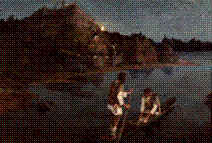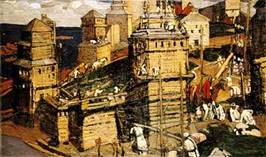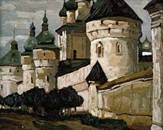Nikolai Roerich
„Сознание красоты спасет мир". (Н. К. Рерих)
"The sense of beauty will save the world" (N. K. Roerich)

Nikolai Roerich
 The name of the Russian painter Nikolai Konstantinovich Roerich (1874-1947) occupies an honorable place in the history of our own country's and the world culture of the XX century.
The name of the Russian painter Nikolai Konstantinovich Roerich (1874-1947) occupies an honorable place in the history of our own country's and the world culture of the XX century.
The range of N. K. Roerich's activities is extraordinarily wide. A painter, archaeologist, ethnographer, lawyer, geographer, poet, historian, philosopher, scientist, traveller, fighter for peace, defender of cultural values of all nations and, invariably, Man, who has devoted his whole self to the ideal of common good.
 As an artist, N. K. Roerich has created more than 7000 works, that has dispersed all over the world, adding to the glory of Russian culture. He worked in the sphere of monumental and applied arts and has become famous as an author of scenographies and drawings, and left the whole series of sketches for furniture, costumes, embroideries. And all this diverse heritage is hall-marked with a great original talent.
As an artist, N. K. Roerich has created more than 7000 works, that has dispersed all over the world, adding to the glory of Russian culture. He worked in the sphere of monumental and applied arts and has become famous as an author of scenographies and drawings, and left the whole series of sketches for furniture, costumes, embroideries. And all this diverse heritage is hall-marked with a great original talent.
Nikolai Konstantinovich was formed as an artist and a public cultural worker of the Russia of the end of the XIX -beginning of the XX centuries. After graduation from Petersburg University and the Academy of Arts he yearned to know the centuries-old culture of Russia. With this purpose in 1903-1904, the young artist went round more than 40 towns and historical places of the country.
 At the end of the thirties N. K. Roerich had to return to the USSR, but the war prevented him from doing this. In 1947, Nikolai Konstantinovich was going to return to his Motherland: "I would like to be there as soon as possible and to contribute my experience and knowledge to the cause of Russia". Packed are his books, pictures. But death cut short the dream of many years.
At the end of the thirties N. K. Roerich had to return to the USSR, but the war prevented him from doing this. In 1947, Nikolai Konstantinovich was going to return to his Motherland: "I would like to be there as soon as possible and to contribute my experience and knowledge to the cause of Russia". Packed are his books, pictures. But death cut short the dream of many years.
N. K. Roerich's public and philosophical views met a keen response in the hearts of millions of people by their humane and vital trend. People who shared his views united on different continents to form 82 societies bearing his name. The fact that over 100 academies, institutes, societies, associations, leagues, federations elected him their full and lifelong member is the best evidence of the Russian artist's popularity and recognition.
 60 pictures by N. K. Roerich are exhibited in the Novosibirsk Picture Gallery. According to father's will his son Yuri N. Roerich presented them to Siberia on returning to his Motherland in 1957. The pictures became a pride of our city. The landscapes from "the Himalayas" series arouse exceptional interest. They opened the beauty of the mountainous world of the East to art. "The spirit of the Himalayas and soul of India are grasped in them", as Indira Gandhi marked the truthfulness of the Russian painter's landscapes.
60 pictures by N. K. Roerich are exhibited in the Novosibirsk Picture Gallery. According to father's will his son Yuri N. Roerich presented them to Siberia on returning to his Motherland in 1957. The pictures became a pride of our city. The landscapes from "the Himalayas" series arouse exceptional interest. They opened the beauty of the mountainous world of the East to art. "The spirit of the Himalayas and soul of India are grasped in them", as Indira Gandhi marked the truthfulness of the Russian painter's landscapes.
Ex. 1. Answer the questions:
- What main life values did Roerich have?
- What was Roerich? Have you seen his pictures? Did you like them?
- What aim did Roerich have when he went round more then 40 towns and historical places of Russia?
- What pictures help us to understand Roerich as a painter?
- What was a Roerich's world-outlook?
- Did N.K. Roerich's public and philosophical views meet a keen response in million peoples' hearts?
- How did his creation reflect in World culture?
- What present did Roerich give to Siberia?
- How did he reflect his motto in his pictures?
- Do you understand Roerich's creation?
- What role did artist's wife play in his creation?
Ex. 2. Find in the text the English equivalents for the following:
занимать почетное место, диапазон деятельности, необычайно, археолог, правовед, историк, борец за мир, культурные ценности, общее благо, многообразное наследие, самобытный талант, с этой целью.
Ex. 3. Define the following key terms:
a painter, culture, art, popularity, recognition.
Ex. 4. Complete the following:
1. The name of the Russian painter N.K. Roerich occupies …
2. The range of N.K. Roerich’s activities is …
3. N.K. Roerich was formed as an artist and …
4. With this purpose in 1903-1904 he …
5. At the end of the 30s he had to …
6. N.K. Roerich’s public and philosophical views met …
7. 60 pictures by N.K. Roerich are exhibited in …
Ex. 5. Revise the active vocabulary and translate the following into English:
 Знание истории, многочисленные археологические раскопки, „хождения по русской старине" помогли Н. К. Рериху по-новому отобразить в своем творчестве образ родной природы и духовные ступени развития тысячелетней истории русского народа. Картины „Гонец" (1897), „Заморские гости" (1901), „Город строят" (1902) "Ростов Великий" (1903), „Три радости" (1916) - это рериховская Русь. Она сразу узнается, как и Россия В. Сурикова, А. Рябушкина, М. Нестерова. Это страна славного прошлого и великого будущего.
Знание истории, многочисленные археологические раскопки, „хождения по русской старине" помогли Н. К. Рериху по-новому отобразить в своем творчестве образ родной природы и духовные ступени развития тысячелетней истории русского народа. Картины „Гонец" (1897), „Заморские гости" (1901), „Город строят" (1902) "Ростов Великий" (1903), „Три радости" (1916) - это рериховская Русь. Она сразу узнается, как и Россия В. Сурикова, А. Рябушкина, М. Нестерова. Это страна славного прошлого и великого будущего.
Ex. 6. Speak on the following topics:
1. The world’s principal religions. Which of them do you share and why?
2. The increasing influence of culture within the contemporary Russian society.
Ex. 7. Comment on the following quotations:
1. The sense of beauty will save the world.
(N.K. Roerich)
2. There is no limit to improvement for people.
3. Culture of the spirit stands upon all boundaries.
Ex. 8. Answer the questions:

Н. Рерих "Настасья Микулична" (1943)
N. Roreich "Nanstasya Mikulichna" (1943)
1. The name of the picture is Nastasya Mikulichna, isn’t it?
2. When was this picture painted? Where is it exhibited now?
3. Who is the artist of this well-known picture?
4. Who mounts a mighty horse?
5. Did the artist use this epic image to represent Russia symbolically?
6. Does Nastasya Mikulishna threaten to anyone?
7. Is she ready to suitably meet any enemy?
8. What does she hold on her right palm?
9. What do these three human figures symbolize?
10. The Russian epos narrates that this woman is of an Asian origin, doesn’t it?
11. Is this image the result of Reorich’s deep reflections?
12. Enemies wouldn’t wipe out the Russian people, would they?
13. What do you feel looking at this canvas?
14. What is the main idea of this painting?
15. Why do you think that the author is a patriot of his Motherland?
16. Is it a symbol of freedom-loving Russia?
Ex. 9. Describe this picture and name some pictures of the famous Russian painter N.K. Roerich.
Ex. 10 Translate the poem:
Примет все наследие Твое
Дух, идущий следом за Тобою;
Примет все страдание Твое
От невежества людей и боли
Тех сердец, затерянных во мгле;
Примет радость бытия в Огне,
Счастья исполненья Высшей воли.
Ex. 11. Answer the questions:

С.Н. Рерих "Портрет Е.Н. Рерих" (1937)
1. Who is this woman in the picture?
2. Where was she born?
3. Who was her husband?
4. What was she interested in?
5. How many sons did she have?
6. What role did she play in her husband’s life?
7. In what countries did she live?
8. What books did she write?
9. What is she famous for?
10. Have you read her books? What are they about?
Ex. 12. Find the Russian equivalents:
1. leading the way
2. against the background
3. the course of life
4. high mission
5. it is not by chance
6. to ascend
7. the strain of spiritual forces
8. to overcome the obstacles
9. the seeker of exploits
10. radiant peaks
Ex. 13. Translate the text into English:

Н.К. Рерих "Ведущая" (1944)
«Ведущая» На фоне высокой горы, символизирующей жизненный путь, изображены женская и мужская фигуры. Это поэма о женщине, о ее высокой миссии. Не случайно героиня изображена в момент восхождения, когда напряжение духовных сил наиболее полно раскрывается. „Преодолевая преграды, отвергнув всякий страх и сомнения, безудержно, неутомимо, героически она ведет „искателя подвига к сияющим вершинам", - так объяснял картину художник.
Ex. 14. Answer the questions:
1. What is the name of this picture?
2. Who painted it?
3. When was the picture painted?
4. Where is it exhibited now?
5. What is depicted in it?
6. What is the main idea of this painting?











